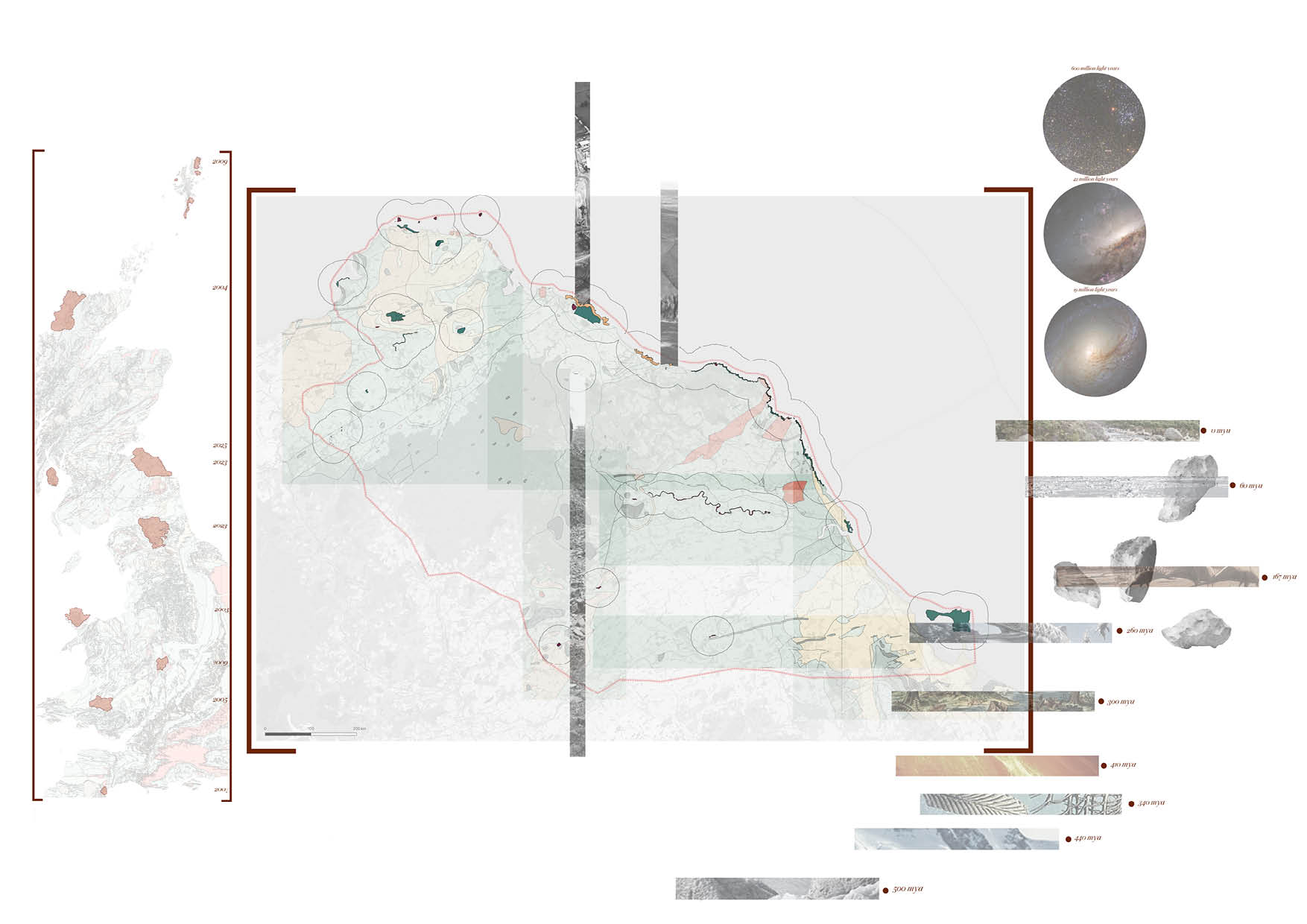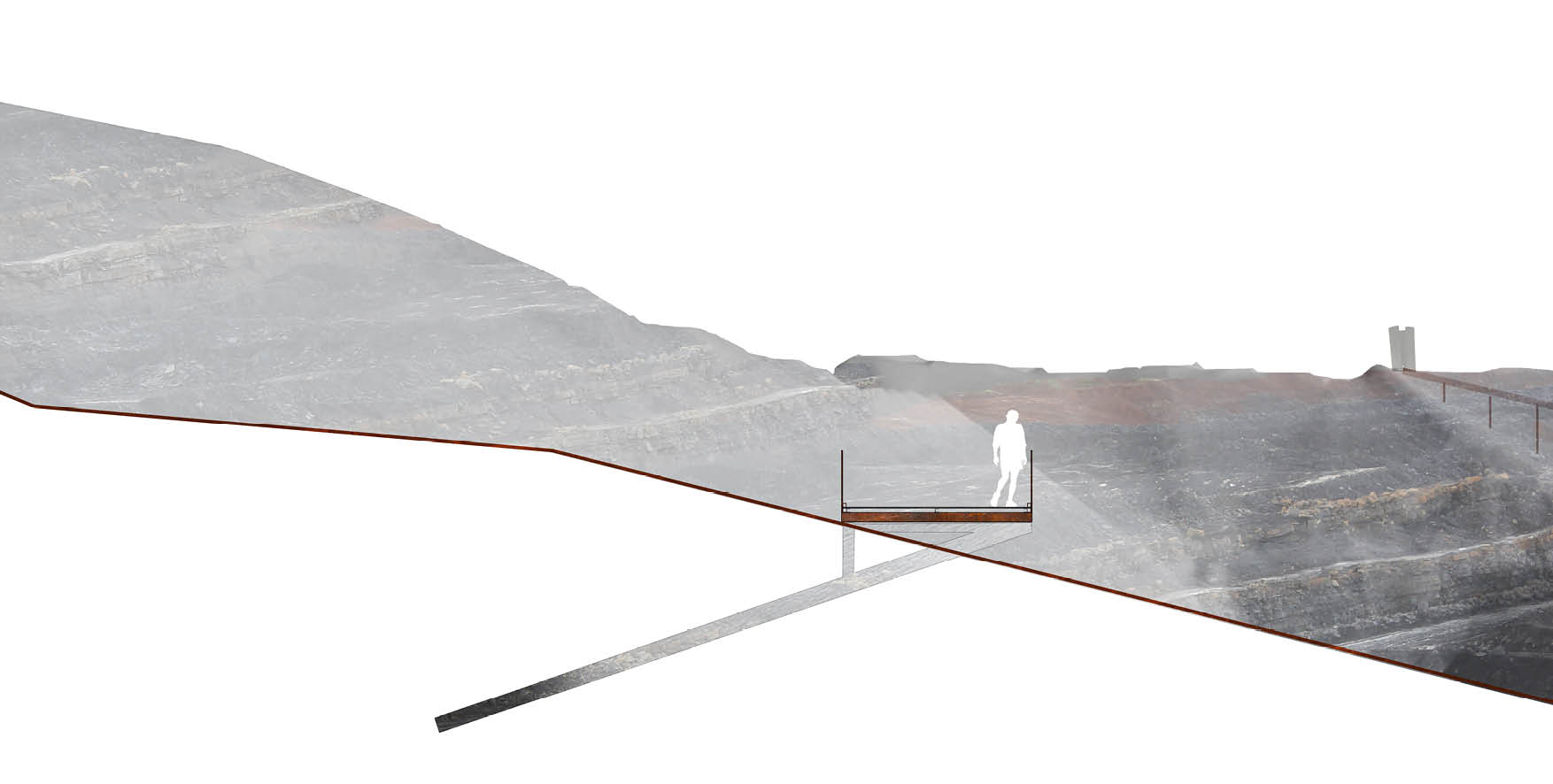

Petra Nostos is located in south east Scotland, a geopark that merges scientific exploration of the Earth’s geological history with artistic and poetic interpretation, offering a deeply immersive experience of the landscape.
Inspired by geopoetics, an interdisciplinary movement that explores the relationship between humans and the Earth through poetic, imaginative, and intellectual means, the park bridges art, science, and philosophy. Rooted in engagement with the natural world, it seeks geological and ecological realities entangled with human experience. Therefore, fostering a renewed sense of planetary belonging. Petra Nostos encourages emotional and intellectual connections with powerful geological features. The design operates at two interconnected scales: a strategic scale represented by Petra Nostos, and a detailed scale, Stellae Scriptorium, a site of reflective engagement with the human and more-than-human. Located within Dunbar Quarry, Stellae Scriptorium acknowledges humans as geomorphic agents.
Together, these layers create a journey through deep time, sensory experience, and creative interpretation.

At a strategic scale, this proposal presents Petra Nostos, a new geopark in southeast Scotland that merges the scientific exploration of Earth’s geological history with artistic and poetic interpretation, offering visitors a deeply immersive and multidimensional experience of the landscape. Drawing from the movement of geopoetics, the park encourages creative engagement with landforms, inviting individuals to connect emotionally and intellectually with the Earth’s dynamic processes.
The name Petra Nostos comes from the Greek words petra, meaning “stone,” and nostos, meaning “homecoming.” It captures the essence of a return to the land, a rediscovery of nature’s vast temporal scales and raw beauty through both geological knowledge and artistic expression.
My vision for Petra Nostos is to redefine what a geopark can be, transforming it into a poetic, immersive experience where visitors engage with the more-than-human world and encounter moments of the sublime.
The proposed geopark spans a geologically diverse region, marked by fossil-rich Carboniferous limestones, ancient Devonian Old Red Sandstone, volcanic intrusions, glacial features, and dramatic coastal exposures. Together, these formations reflect a long and complex history shaped by tropical seas, tectonic upheavals, erosion, and human intervention through quarrying and land use. These overlapping stories of natural process and cultural practice provide fertile ground for interpretation through both scientific and creative lenses.
Among the many notable sites within the proposed boundary is Siccar Point, internationally recognised as the place where James Hutton observed the unconformity that helped him formulate the concept of deep geological time. It adds value as an iconic site alongside others in the region, reinforcing southeast Scotland’s historical importance to the development of geological science.
At a detailed scale, this project focuses on the Stellae Scriptorium site, an active quarry located within Petra Nostos and situated in the larger Dunbar region. Quarrying in this area has a long history, with evidence of continuous limestone extraction dating back nearly two centuries. This enduring industrial activity is deeply embedded in the landscape and its cultural heritage.
Rather than following the common practice of backfilling and restoring quarry voids, my design proposes to keep the Stellae Scriptorium quarry open and accessible. This approach reimagines the role of waste rock, typically viewed as a byproduct to be discarded, as a valuable resource to expose and celebrate the quarry’s deep time history. By utilizing waste rock to reshape the terrain, I aim to reveal the layers of industrial activity and geological transformation that define the site.
The surrounding region has hosted many limestone quarries, including Oxwell Mains, Catcraig, and Skateraw, that have all been backfilled and regraded, erasing visible traces of past extraction and human geomorphic processes. Unlike these, this project seeks to retain and reinterpret those transformations. Waste rock stockpiled on site, which I observed during my first semester field trips, will become the raw material for a new landscape typology, one that reveals and honors the industrial legacy rather than concealing it.

This plan presents the Stellae Scriptorium site within the Petra Nostos Geopark as it stands in the year 2033, a pivotal moment when visitors first encounter the unfolding transformation of the active quarry. Set within Dunbar’s North East Quarry, the design retains the quarry as an open and evolving landscape, revealing nearly 330 million years of geological history embedded in its exposed rock strata.
Key spatial features define the site: the water-holding Nymphaeum Core, the network of guiding paths known as the Stellae Trace, the terraced Ziggurats constructed from repurposed quarry waste rock, the towering Stellae Obelisk, and the subterranean Cavum Astrum. Each element is designed with a focus on human scale while also aiming to evoke a profound more than human experience.



Geopoetics seeks to reveal the more than human, encouraging a way of seeing that transcends the human scale. In thinking about geology through this lens, I began to expand the definition beyond Earth, considering how geological processes and rock formations exist not only on our planet but across the universe. This includes extraterrestrial features such as lunar basalt plains, Martian sedimentary layers, asteroid surfaces scattered with regolith, and icy crusts on moons like Europa.
This constellation concept became a central driver for the project’s name, Stellae Scriptorium—Latin for “a place where the stars are written.” The name reflects both the astronomical inspiration behind the design and the poetic invitation for visitors to interpret their own meaning within the space. The connection is implicit and open-ended, encouraging a deeply personal experience. Rather than prescribing a single narrative, the landscape becomes a canvas for reflection, allowing each visitor to form their own sense of wonder, belonging, and connection to the cosmos.



One of the central challenges in designing Petra Nostos was negotiating the tension between the vast, more than human scales of poetics, deep time, constellations, and geology, and the intimate, embodied scale of human experience.
The design navigates between practical, human scale interventions and the overwhelming vastness of geological time and space. Construction drawings and grounded strategies ensure that poetic and emotional responses are supported by practical forms, bridging the human and the cosmic in ways that are both deeply felt and physically achievable.








For me as a designer, geopoetics has unlocked an experimental, site-specific, informed, and multidisciplinary way of working. It has given me permission to explore boldly through model-making, poem-writing, painting, and decisive design gestures. Geopoetics invites us to embrace the more-than-human. It is grounded in planetary belonging, something that stretches beyond the limits of bodily experience. That’s why my design is monolithic, geometric, and unapologetically bold. It is human, and it is more-than-human.



Landscape architecture is still a relatively young profession, but it is deeply tied to ancient, poetic ways of knowing. The more we embrace multidisciplinary thought, the more radical and revolutionary we can become. We can become more than us, more than landscape, more than human.
That is what Petra Nostos stands for. It is a provocation. And that’s exactly what I want. That’s what the geopoets want. As landscape architects, we hold the rare skill to balance between logic and intuition. We already feel the planet poetically, so let’s use that poetic sensitivity to create unique, bold, and grounded designs.